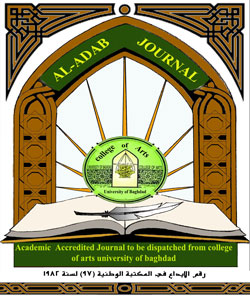The parallel texts of the film text
DOI:
https://doi.org/10.31973/aj.v1i130.635Keywords:
Text, parallel texts, film textAbstract
The texts parallel to the original text are of importance in being the thresholds for the entry of the original text, and add to the text how much information and knowledge, and if the studies came to look at the written texts, and in the approaches between the film text and other texts, we find the parallel texts of the film (poster, title, The first chapter, which contained the methodological framework of the research. The problem of the research was the following question: How can the parallel texts be good thresholds to enter the worlds of text? The aim of the research also included the disclosure of these parallel texts The second chapter / theoretical framework on two subjects was first titled (text and film text), which dealt with the concepts of text and film text and parallel texts, while the second section (parallel texts of the film text) came looking at the parallel texts of the film text. The third chapter included the research procedures. The fourth chapter came to practical application of the parallel texts. The research also included the results of the research
Downloads
References
Abdul Aziz Al-Sayed, Alaa: The Film Between Language and Text, General Film Organization, Damascus, 2008.
Al-Abdali, Abdul-Razzaq: Promotion and Advertising, Dar Al-Kutub for Printing and Publishing, Iraq, Mosul, 1993.
Al-Matawi, Al-Hadi: - Poetry of the title of the leg on the leg, while it is Al-Friyak, Alam Al-Fikr Magazine, Vol. (28), No. 1, Kuwait, 1999.
Al-Naseer, Yassin: The Narrative Initiation and the Dynamics of the Beginnings in the Fiction Text, Al-Qalam Al-Iraqiya Magazine, Vol. 11, 1989. Sources from the films
Aristotle: The Art of Public Speaking, Abdul Rahman Badawi, Ministry of Culture and Information, Baghdad, 1980.
Bakhtin, Mikhail: The Fictional Discourse, translated by Muhammad Barada, Dar Al-Fikr for Studies, Publishing and Distribution, Cairo, Paris, 1987.
Bart, Roland: Lessons of Biology, Madarat Publishing House, Amman, Jordan, 2004.
Bart, Roland: Textual Perspectives - Text Theory, House of Cultural Affairs, Baghdad, 1996.
Belayid, Abdelhak, Atabat (Gerard Gent from Al-Nass to Al-Manas), published by Ikhtilaf, Algeria, 2008.
Bilal, Abd Al-Razzaq: An Introduction to the Thresholds of the Text: A Study in the Introductions to Western Prose, Africa House, Morocco, 2000.
Bin Dhiril, Adnan: Text and Style, Arab Writers Union Publications, 2000.
Hamon, and others: The Poetics of the Narrative, Publications of the General Book Authority, Damascus, 2010.
Harb, Ali: So, Read After the Dismantling, The Arab Foundation for Studies and Publishing, Beirut, 2010.
Helmy Matar, Ameera: An Introduction to Aesthetics, Dar Al-Nahda Al-Arabiya, Cairo, Egypt, B.T.
John Logan: The Pilot, directed by Martin Scorsese, 2004, Leonardo DiCaprio, Cate Blanchett
Judge Mohamed and others: Dictionary of Narratives, International Association of Independent Publishers, Tunis, 2010.
Khamri, Hussein: Text Theory, Ikhtilaf Publications, Algeria, 2007.
Michel Marie and Jacques Amon: Film Analysis, Terr Antoine Homs, Damascus, 1999.
Muhammad Saeed, Abu Talib: The Science of Research Methods, Dar Al-Hikmah for Printing, Mosul, 1990.
Ricoeur, Paul: From Text to Verb, Dar Contagion, Algeria, 2010.
Tree of Life, screenplay and directed by Trans Malick, United States, 2011, Brad Pitt, Jessicachstein.
Downloads
Published
Issue
Section
License
Copyright and Licensing:
For all articles published in Al-Adab journal, copyright is retained by the authors. Articles are licensed under an open access Creative Commons CC BY 4.0 license, meaning that anyone may download and read the paper for free. In addition, the article may be reused and quoted provided that the original published version is cited. These conditions allow for maximum use and exposure of the work.
Reproducing Published Material from other Publishers: It is absolutely essential that authors obtain permission to reproduce any published material (figures, schemes, tables or any extract of a text) which does not fall into the public domain, or for which they do not hold the copyright. Permission should be requested by the authors from the copyrightholder (usually the Publisher, please refer to the imprint of the individual publications to identify the copyrightholder).
Permission is required for: Your own works published by other Publishers and for which you did not retain copyright.
Substantial extracts from anyones' works or a series of works.
Use of Tables, Graphs, Charts, Schemes and Artworks if they are unaltered or slightly modified.
Photographs for which you do not hold copyright.
Permission is not required for: Reconstruction of your own table with data already published elsewhere. Please notice that in this case you must cite the source of the data in the form of either "Data from..." or "Adapted from...".
Reasonably short quotes are considered fair use and therefore do not require permission.
Graphs, Charts, Schemes and Artworks that are completely redrawn by the authors and significantly changed beyond recognition do not require permission.
Obtaining Permission
In order to avoid unnecessary delays in the publication process, you should start obtaining permissions as early as possible. If in any doubt about the copyright, apply for permission. Al-Adab Journal cannot publish material from other publications without permission.
The copyright holder may give you instructions on the form of acknowledgement to be followed; otherwise follow the style: "Reproduced with permission from [author], [book/journal title]; published by [publisher], [year].' at the end of the caption of the Table, Figure or Scheme.












